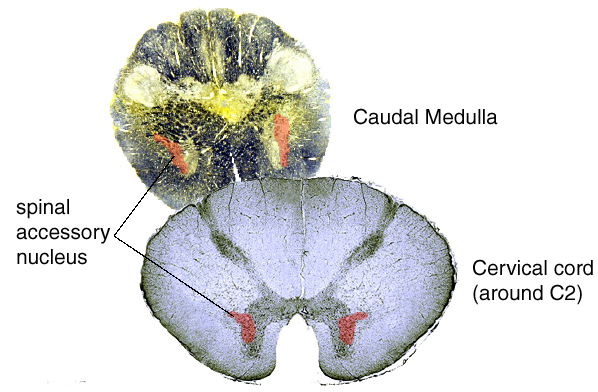Lab 9 (ƒ 10) - Cranial Nerve Nuclei and Brain Stem Circulation
Cranial Nerve XI - Spinal Accessory Nerve
The spinal accessory nucleus extends from the caudal medulla to about C5. Axons from the spinal accessory nucleus travel in the spinal accessory nerve to end in part of the trapezius and sternocleidomastoid muscles.  The movements these muscles generate are head rotation, flexion and shoulder shrug.
The movements these muscles generate are head rotation, flexion and shoulder shrug.
Destruction of the spinal accessory nerve produces weakness in rotating the head against resistance toward the side opposite the lesion and atrophy of the sternocleidomastoid. The patient cannot shrug the affected shoulder and exhibits a mild drooping of the affected shoulder with the scapula displaced downward.
Fibers from the nucleus ambiguus travel in the spinal accessory nerve within the skull, join the vagus nerve outside the skull, and end in the intrinsic muscles of the larynx.
The cortical input to the spinal accessory nucleus is bilateral and direct for volitional control of head rotation. Interruptions of the corticobulbar fibers (upper motor neuron lesions) produce very mild symptoms that are difficult to recognize unless the fibers are injured bilaterally. Diseases of the corpus striatum may result in torticollis, a repeated involuntary movement of the head toward the normal side.
Clinical Testing of Cranial Nerve XI:
- Ask to shrug shoulders (trapezius): place both hands on patient's trapezius muscles above shoulders, and ask the patient to shrug against resistance.
- Ask to turn head against force (sternocleidomastoid): place hands against patient's jaw and ask the patient to turn head against resistance of hand. Perform procedure on both the right and left sides.
